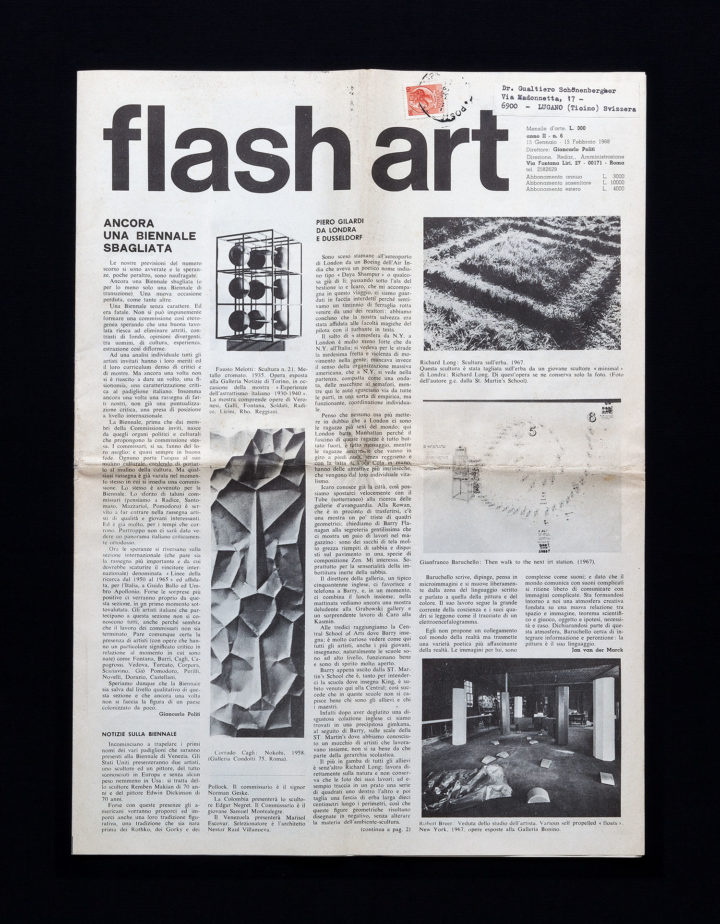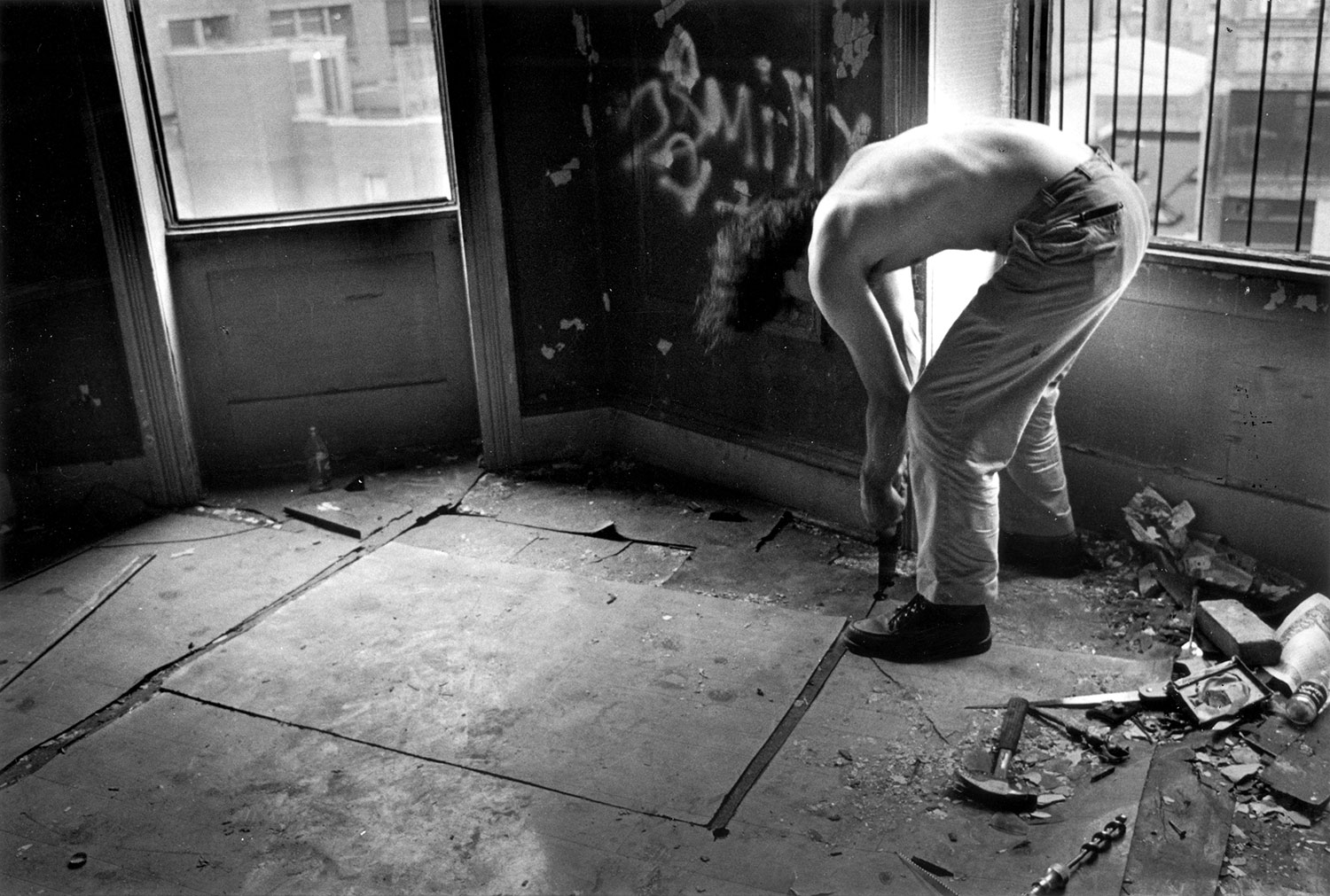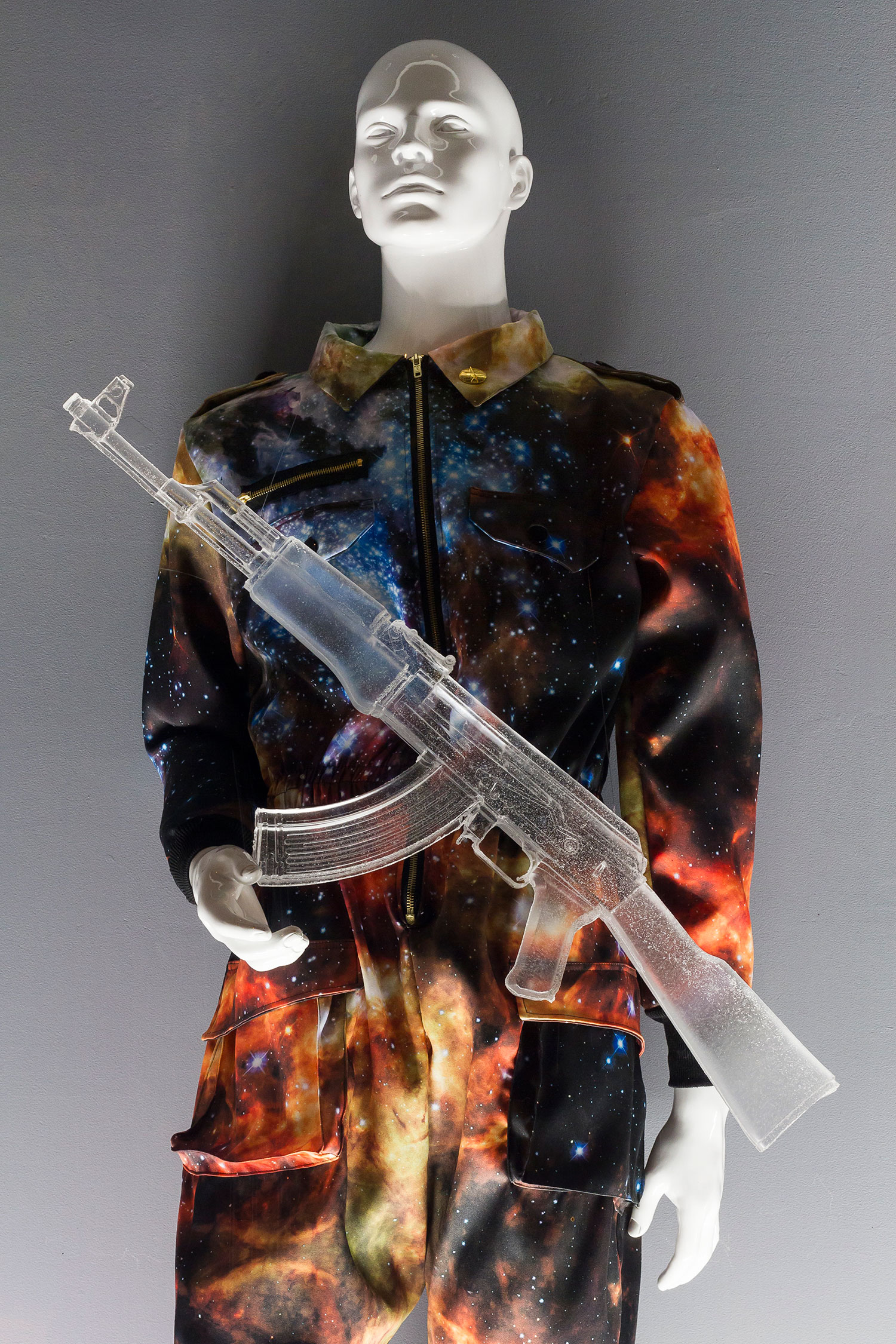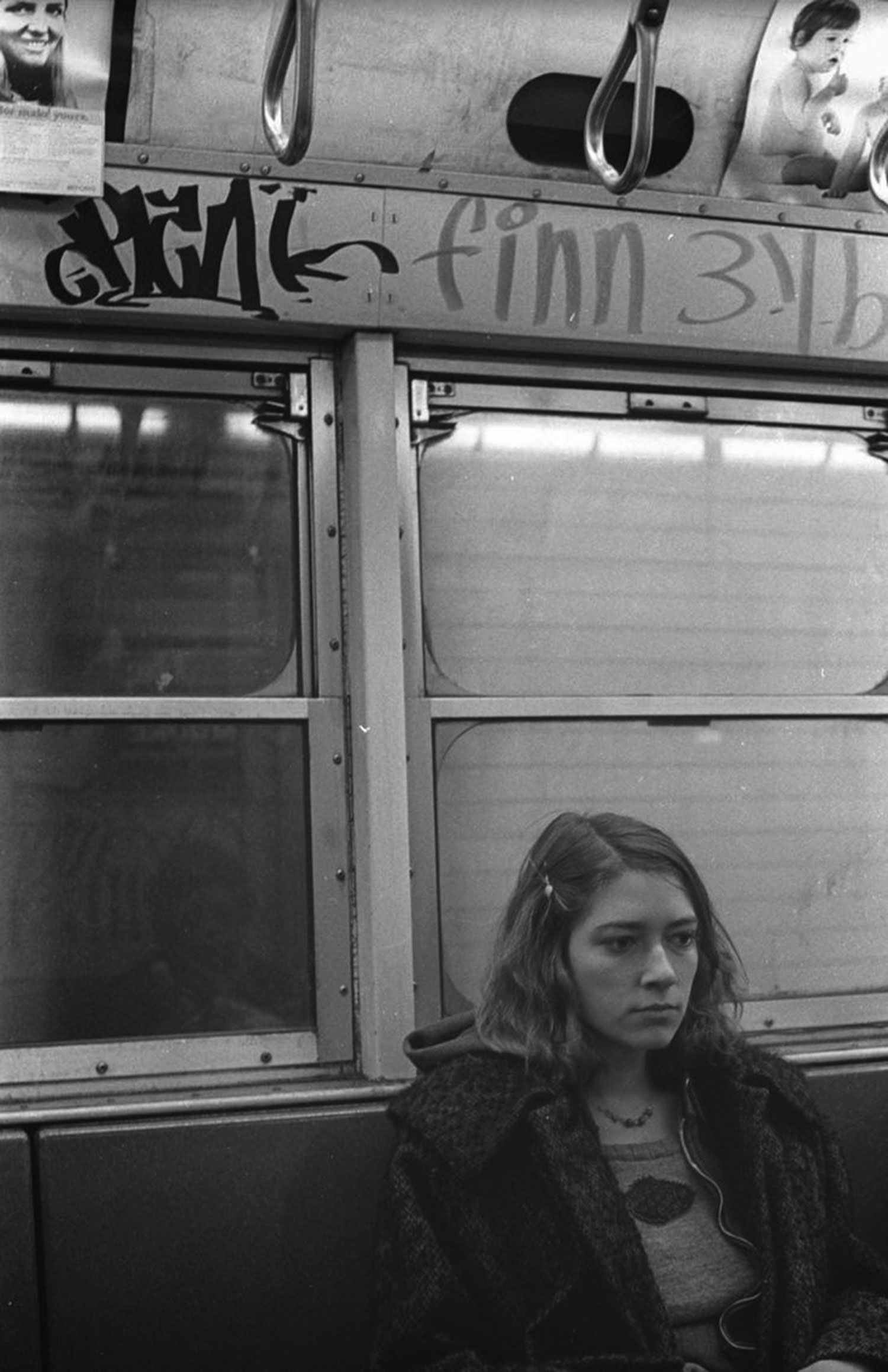 In 1967 and 1968, Flash Art published Piero Gilardi’s diary of his travels between the United States and Northern Europe. In reassessing those texts, Marco Scotini reveals the significant role that Gilardi played in promoting the emergence of the post-Minimalist, poverista and conceptual art tendencies of the 1960s.
In 1967 and 1968, Flash Art published Piero Gilardi’s diary of his travels between the United States and Northern Europe. In reassessing those texts, Marco Scotini reveals the significant role that Gilardi played in promoting the emergence of the post-Minimalist, poverista and conceptual art tendencies of the 1960s.
It is well known that in the spring of 1969 two landmark events in the history of exhibitions defined a new theoretical foundation for contemporary art: for its forms of production and reception, its distribution of roles, its modes of being. Having since become mythical, in one case, and fallen into obscurity, in the other, the shows “When Attitudes Become Form” and “Op Losse Schroeven” reemerge today as the twin gears of a single exhibition machine: an apparatus capable of marking a paradigmatic shift in the definition of art and its institutional relations, in response to the centrifugal and libertarian social transformations of 1968.
Inaugurated one week apart and helmed, respectively, by Harald Szeemann and Wim Beeren, the two parallel shows at the Bern Kunsthalle and the Stedelijk Museum in Amsterdam involved — albeit with relevant differences — more or less the same artists (from both sides of the Atlantic), and adopted the same installation strategies (improvised and informal) as well as similar spatial configurations. Finally, they both gave shape to the post-Minimalist, poverista and conceptual artistic tendencies that were to remain hegemonic for years to come.
If all this is common knowledge by now, what is less widely recognized is the key role played in the two shows by Piero Gilardi — despite recent reconsiderations offered by people such as Christian Rattemeyer and Robert Lumley. If we were merely to attribute to an artist like Gilardi the role of the shows’ advisor, we would find ourselves very far from both an accurate historiographic reconstruction and an adequate formulation of the theoretical problem that his participation in the process implies. Rather, recuperating this genealogy opens a whole series of crucial questions regarding not only the figure of Gilardi (in all its complexity and potentiality) but, more broadly, the concrete ways in which cultural systems and creative industries have been (and still are) wont to sink into the depths of the relations of production via the strategies of valorization that they mobilize and the forms of control that they legitimize.
What, then, is the current significance of reaffirming Gilardi’s propulsive force within this process? What questions are once again pulled into focus by rehabilitating his experience? What certainties are undermined? The historical record, in and of itself, would have little meaning if it couldn’t be transformed into a paradigmatic factor and, in other words, into an appeal to shift (if not to reverse) current interpretative canons. As a matter of fact, the years between 1967 and 1969 are those in which Gilardi abandoned the production of his renowned tappeti-natura [nature carpets] and, with them, an object-oriented approach to art (here understood as “art intended for use”), in full accordance with the processes of dematerialization that were being defined at the time. The febrile assumption of the role of catalyst and theoretician, which replaced the Turinese artist’s previous activity, did not however stop him from exercising his creativity. Rather, this new initiative saw him move from inventing forms to inventing formations, with dedicated spaces to accommodate them (such as the Deposito d’Arte Presente in Turin) and proper names to designate them (such as the term “microemotive art”). His travels between the United States and northern Europe, much like his correspondence with the newly established Flash Art and his publications in the American Arts Magazine, the Swedish Konstrevy and the French Robho, were the tools of this new creative phase. But it’s above all from the pages of Flash Art that we learn which artists Gilardi was going around the world selecting, in order to then recommend them to both Beeren and Szeemann for the two big shows. The species of travel diary that Gilardi published in five installments in Flash Art over the course of a year, from September 1967 to December 1968, is a veritable construction site, a repository of his overtaking of both the Pop and Minimalist scenes, in tandem with the emergence of a new generational tendency that Gilardi defined as “primary energy” (in reference to “primary structures”) or microemotive art. The crucial pages of Flash Art essentially become a sort of backstage for “Op Losse Schroeven” and “When Attitudes Become Form.” A few names, unknown until then, make their way into Italy for the first time, such as Joseph Beuys (“a real German character”1), Richard Long (“the finest of all the students” at Central Saint Martins2) and Marinus Boezem (“the most representative character of a certain northern artistic lifestyle”3). Others — some of them well known, like Bruce Nauman, Keith Sonnier and Barry Flanagan — begin to spread out in a constellation of which Gilardi writes: “We are still far from synthesizing a new artistic dimension, but we can feel the presence, strong and decisive, of a new mental propensity for inhabiting entropy in an individual way.”4
Gilardi began his tour in New York, where he was getting ready to close his important show at the Fischbach Gallery. The show was an explicit departure — both mentally and physically — from the Pop art that was consecrated in Venice three years prior. To wit, Gilardi stepped naked out of the transparent bathtub on the set of The Loves of Ondine (1968), in front of Andy Warhol, who stopped him with “a fake-enthusiastic: terrific!”5 But even the spatial inertia of the minimal seemed to him to be superseded by an opening toward “time.” Among hippies, anti-Vietnam demonstrations and McLuhan-style electronic messages, Gilardi moved — accompanied by Paolo Icaro or Tommaso Trini — from New York to London, from Dusseldorf to Amsterdam, all the way to Stockholm. He became convinced that there was, among these various centers, “a strong, albeit unconscious, unity of intentions.” “I feel,” he wrote, “that right now the research carried out by certain Italian artists is not different from Boezem’s or Long’s or Nauman’s, not because there is a universality of language developing but, on the contrary, because it’s been overcome through a primary vision and a concrete, individualistic perspective.”6 The names that Gilardi mentions — Carl Andre, Joseph Beuys, Marinus Boezem, Ger van Elk, Barry Flanagan, Olle Kaks, Eva Hesse, Paolo Icaro, Richard Long, Robert Morris, Bruce Nauman, Pino Pascali, Keith Sonnier, Frank Viner, Gilberto Zorio — all end up in the list of artists included in the two big shows. In this broad artistic constellation, Harald Szeemann is the last protagonist that Gilardi meets, after having grouped around himself in Turin the young, so-called poverista community, and having established relationships with Dutch artists like Boezem and van Elk, as well as with the curator Wim Beeren. As Jan Dibbets remembers, “Gilardi had spoken to all of us early on [before being in touch with Szeemann] and he was interested in uniting a group of artists. He played a key role, saying that we should all join together, unite in a different approach towards art — changing how art was sold, challenging the gallery and museum systems.”7 Likewise for Boezem, it was precisely Gilardi who “made minds ready for ‘Op Losse Schroeven’ in the Netherlands.”8 Indeed, the first draft of the project that Beeren presented to the director of the Stedelijk Museum in December 1968 was called “Cryptostructures and Microemotions,” a title lifted directly from the concept of microemotive art formulated by the Turinese artist. Gilardi’s essay “Primary Energy and the Micro-emotive Artists” had in fact been published in September in Arts Magazine, while the Dutch version (“Microemotive Art”) had appeared in the Stedelijk Museumsjournaal with an introduction by van Elk.

The conceptual framework through which Gilardi read different artists — from Nauman to Hesse, Long to Merz, Boezem to Zorio — was rooted in the molecular dimension of movement, the unfathomability of energy, perceptual broadening, and a questioning of the primacy of visibility that had been the key element of modernism. A new condition was coming into sight: one that would allow for an opening toward total creative action — freed as much from objects as from signs — as well as for a definitive participation in reality through the promised reconjoining of art and life. “Individuating the subtle energetic relationship between a thing and the negation of things”9 meant, for Gilardi, choosing to use the indeterminacy between form and action as a tool. The fact that, in this modality, primary energy would be opposed to “primary structures,” and the microemotive scale opposed to the macro scale of the “monumental inaction” of entropy (as proposed by Robert Smithson), was something of which he was gradually becoming aware.
Wim Beeren’s debt to the Turinese artist was acknowledged in his essay for the catalogue, as well as by the text “Politics and Avant-Garde,”10 which Gilardi penned for the same publication. The person who would completely obscure Gilardi’s emblematic involvement in the preparatory phases of “When Attitudes Become Form” was Szeemann himself, following a substantial disagreement regarding the show’s management, the political stakes of which are resurfacing today — in this era of the financialization of art — in all of their radicality. In a diary entry from late November 1968, Szeemann wrote: “The night of discussion at van Elk’s place revolves less around the necessity of the exhibition than around the way it should be carried through. Gilardi wanted to see the whole thing as an assembly of artists, from which the exhibition would then naturally emerge: no shipping of works, no art dealers, but rather the results of discussions among artists and the self-criticism of the museum. The title of the exhibition should thus be as noncommittal as possible, rather a new hit that postulates a movement again.”11 As is well known, these expectations would end up being completely betrayed, and the show’s anticipated forms of collective self-production would pivot into their exact opposite: into private funding by the Philip Morris company and the involvement of a dealer like Leo Castelli. Equally well known is the fact that the appointment of the Swiss curator itself acted as a real detonator for Gilardi who, in perfect line with the dictates of 1968, was forced to rethink both his own role and the outcomes of the avant-garde movement that he had helped to configure. He would end up not only withdrawing his name from the initiative but abandoning the very system of art, in order to move toward a form of more direct action within life. In this case, too, Gilardi had to close off the new path with a bitter recognition of the limits that capitalism imposes on the subject and his possibilities for action. As far as the micro-breaks, the micro-freedoms that are reabsorbed into the grind of the institution, the only grievous solution that remained was the one according to which “art has to stay art, maybe a bit mad and arrogant, but not become life.”12
To interpret art-life dualism in a vitalistic sense, that is, as an overflow or a flux juxtaposed to the inertia of representation, would be totally insufficient (if not misleading) with respect to Gilardi’s radical research, and would leave us rooted in a poverista aesthetic that does not reflect him. For Gilardi, the antagonism of the art-life binomial doesn’t appear in a fundamental moment of modern existence so much as in a further moment of the domination of capital. Beyond the critique of a becoming that is reduced to images, beyond the direct privileging of the lived over the represented, there lies the conflict between the productive forces of society and the relations of production. The separation between these forces and what they can do emerges ever more clearly in the aftermath of 1968. Gilardi was among the first to recognize lucidly that art is not an exteriority given to market relations. So that wherever the difference between artistic practice and action disappears, as in microemotive art, reification into signs and things would appear to be impossible. Yet in this case too bringing art to life turns out to be impracticable, for we are still dealing with a space that needs first to be decolonized. It is for this reason that the process of capture and integration set off by “When Attitudes Become Form” and “Op Losse Schroeven” (but also by “Arte povera più azioni povere” in Amalfi), as well as the voluntary subjugation of the avant-garde artists, assumed in Gilardi’s eyes the semblance of failure and counterrevolution.





